When it comes to health and safety, many people are turning to natural remedies as a way to harness the power of nature. In the UK, herbal remedies have a long history of use in healing practices. By creating a DIY Herbal First Aid Kit, you can have a variety of herbal remedies on hand for common injuries and ailments. Not only are these remedies often more affordable and accessible than traditional medicine, but they can also provide a holistic approach to healing.
Key Takeaways:
- A DIY Herbal First Aid Kit can provide a natural approach to health and safety in the UK.
- Herbal remedies have a long history of use in healing practices and can be used for various ailments and conditions.
- Selecting essential herbs, understanding preparation methods, and incorporating safety considerations are crucial steps when creating a DIY Herbal First Aid Kit.
Understanding Herbal Remedies
Herbal remedies have been used for centuries for natural healing and are an essential part of traditional medicine. Also called herbal medicine, it involves using plants or plant extracts to manage and prevent various health conditions. Unlike synthetic drugs, herbal remedies are natural and often have fewer side effects.
Herbal practitioners and healthcare professionals worldwide use herbal remedies to treat a range of ailments, including digestive problems, respiratory infections, and skin conditions. The effectiveness of herbal remedies depends on identifying the cause and symptoms of the health condition and selecting the appropriate herbs.
The history of herbal medicine is long and rich, dating back thousands of years. Many cultures worldwide have their own unique traditions and remedies based on local plants and herbs. In the UK, traditional herbal medicine has been used for centuries, and there are still many herbalists and practitioners who offer treatments.
Herbal remedies work by using the healing properties of plants. Different plants have specific properties that can help treat different health conditions. For example, chamomile is known for its calming and anti-inflammatory properties and is often used to soothe digestive problems and reduce anxiety.
Understanding herbal remedies involves learning about the different herbs and their properties and how to use them safely and effectively. Herbal remedies are available in various forms, including teas, tinctures, capsules, and creams. Proper preparation methods are crucial to ensure correct dosages and effectiveness.
While herbal remedies can be effective for various ailments, it is essential to seek professional advice before using them, particularly if you have any pre-existing medical conditions or are taking any medication.

Overall, herbal remedies offer a natural and effective way to manage many health conditions. Understanding the benefits of herbal remedies and how to use them correctly can help you achieve better health and wellbeing.
Selecting Essential Herbs for Your First Aid Kit
Creating a DIY Herbal First Aid Kit is an excellent way to harness the healing power of nature. However, choosing the right herbs can be daunting, especially if you’re new to herbal remedies. The key is to start with essential herbs that offer a range of healing properties. Here’s a list of the most commonly used herbs and their benefits:
| Herb | Benefit |
|---|---|
| Arnica | Relieves pain, swelling, and bruising |
| Calendula | Heals wounds and soothes skin irritation |
| Chamomile | Relieves anxiety, insomnia, and stomachache |
| Echinacea | Boosts the immune system and fights infection |
| Garlic | Antibacterial and antiviral properties, boosts the immune system |
| Ginger | Alleviates nausea, vomiting, and motion sickness |
| Lavender | Calms the nerves, relieves anxiety and depression, promotes relaxation |
| Peppermint | Relieves headaches, indigestion, and nausea |
| St. John’s Wort | Relieves mild to moderate depression and anxiety |
| Valerian | Relieves anxiety, insomnia, and stress |
When selecting your herbs, it’s essential to choose high-quality, organic options that are sustainably sourced. Look for reputable suppliers who specialize in herbal remedies and can provide certificates of analysis. Avoid purchasing herbs from unknown sources or those that are not certified organic.
It’s also important to consider any pre-existing medical conditions or allergies before using herbal remedies. Certain herbs may interact with medications or cause adverse reactions in some individuals. If you’re unsure, consult with a healthcare professional before using any herbal remedies.
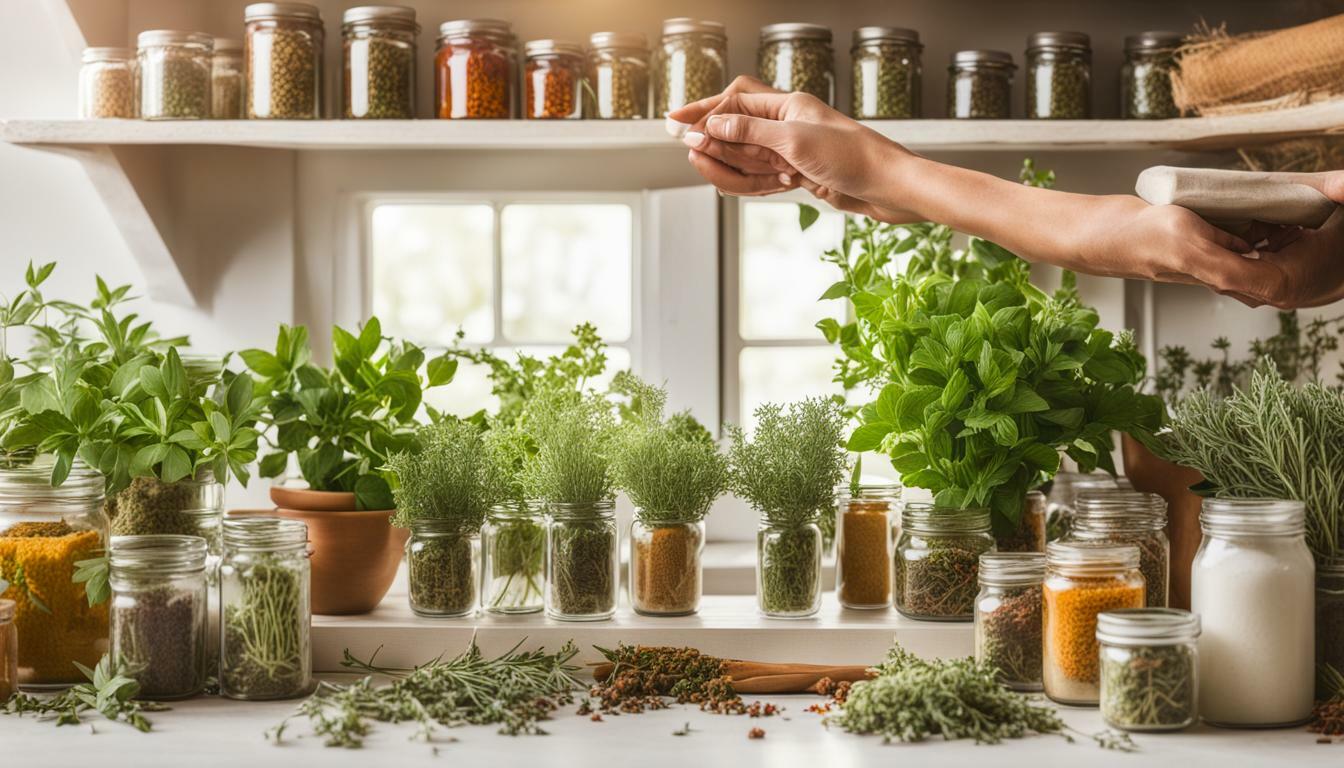
Herbal Preparation Methods
Once you’ve selected your essential herbs, it’s time to prepare them for use in your DIY Herbal First Aid Kit. There are several methods for creating herbal remedies, each with its own benefits and precautions.
Infusions
Infusions are made by steeping herbs in hot water, similar to making tea. This method is ideal for delicate plant parts like leaves and flowers. To make an infusion:
- Boil water and let it cool for a few minutes.
- Add the herbs to a tea ball or muslin bag and place it in a cup or jar.
- Pour the hot water over the herbs and let steep for 5-20 minutes, depending on the herb.
- Remove the tea ball or bag and enjoy!
Note: Always check that the herb you’re using is safe for consumption and follow dosage recommendations carefully.
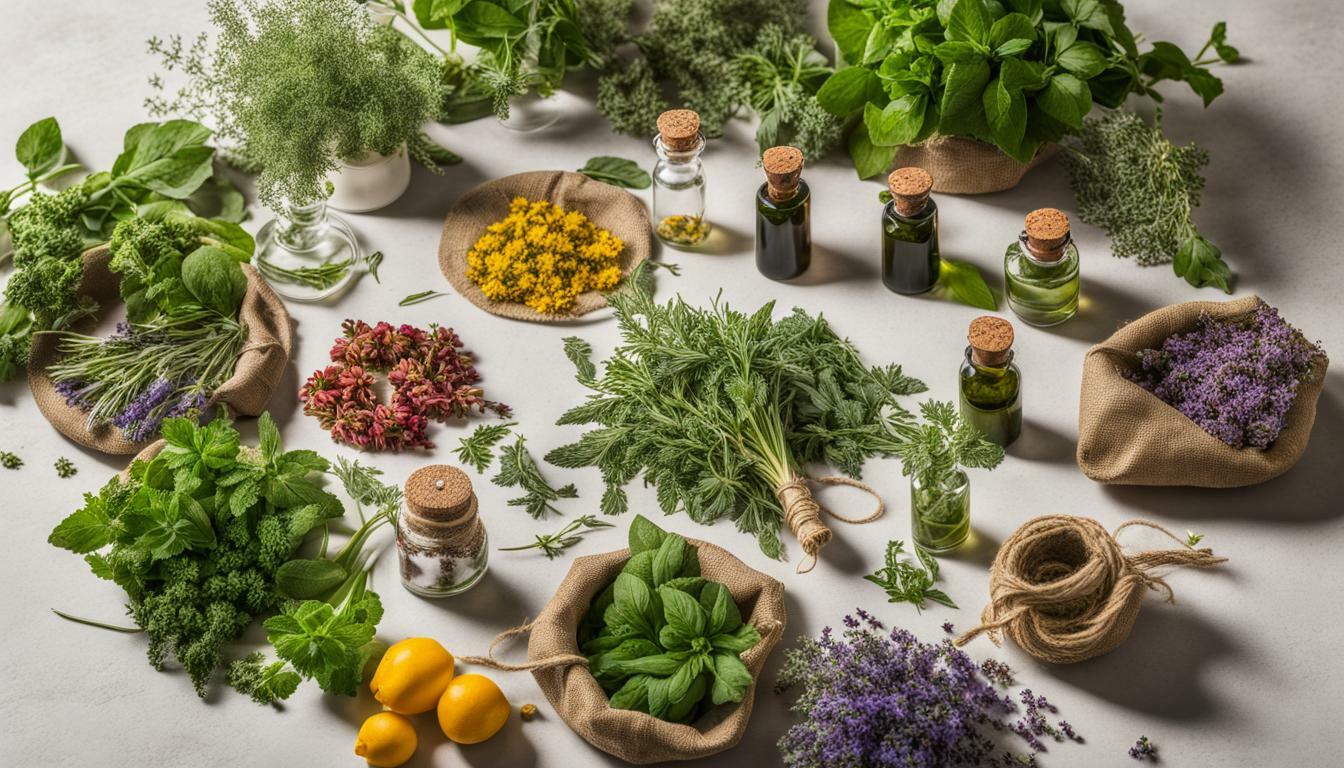
Decoctions
Decoctions are similar to infusions but are used for tougher plant parts like roots, barks and seeds. To make a decoction:
- Crush or chop the herbs to expose more surface area.
- Place the herbs in a pot and add cold water. The ratio should be one-part herb to eight parts water.
- Bring the mixture to a boil and let it simmer for 30-60 minutes.
- Strain the mixture and store the liquid in a glass jar.
Note: Always use a non-reactive pot, like stainless steel or glass. Never use aluminum or copper.
Tinctures
Tinctures are concentrated herbal extracts made by soaking herbs in alcohol. This method is used for long-term storage and is ideal for emergency first aid situations. To make a tincture:
- Chop the herbs and place them in a glass jar.
- Add alcohol (vodka or brandy work well) until the herbs are completely covered.
- Seal the jar and store it in a dark place for 4-6 weeks, shaking it once a day.
- After 6 weeks, strain the liquid and store in a dark glass bottle.
Note: Always label tinctures with the herb name and alcohol percentage. Tinctures are highly concentrated and should be used only under the guidance of a healthcare professional.
Essential Herbs for Common Ailments
Herbal remedies have been used for centuries to alleviate a range of common ailments, from cuts and burns to headaches and colds. Here are some essential herbs to include in your DIY Herbal First Aid Kit:
| Herb | Benefits |
|---|---|
| Calendula | Antibacterial, anti-inflammatory, promotes wound healing |
| Lavender | Relieves stress and anxiety, promotes relaxation, eases headaches and migraines |
| Arnica | Reduces inflammation and pain, promotes healing of bruises and sprains |
| Chamomile | Relieves stress and anxiety, promotes relaxation, eases digestive issues |
| Peppermint | Relieves nausea and vomiting, eases headaches and tension, aids digestion |
| Echinacea | Boosts immune system, relieves cold and flu symptoms, fights infections |
These are just a few examples of the many herbs that can be used for natural first aid. It’s important to research the specific benefits and uses of each herb before using them. Additionally, ensure that the herbs you use are organic, sustainable and of high quality.
It’s important to note that herbal remedies should not replace medical treatment for serious or life-threatening conditions. Seek professional medical advice in these situations.
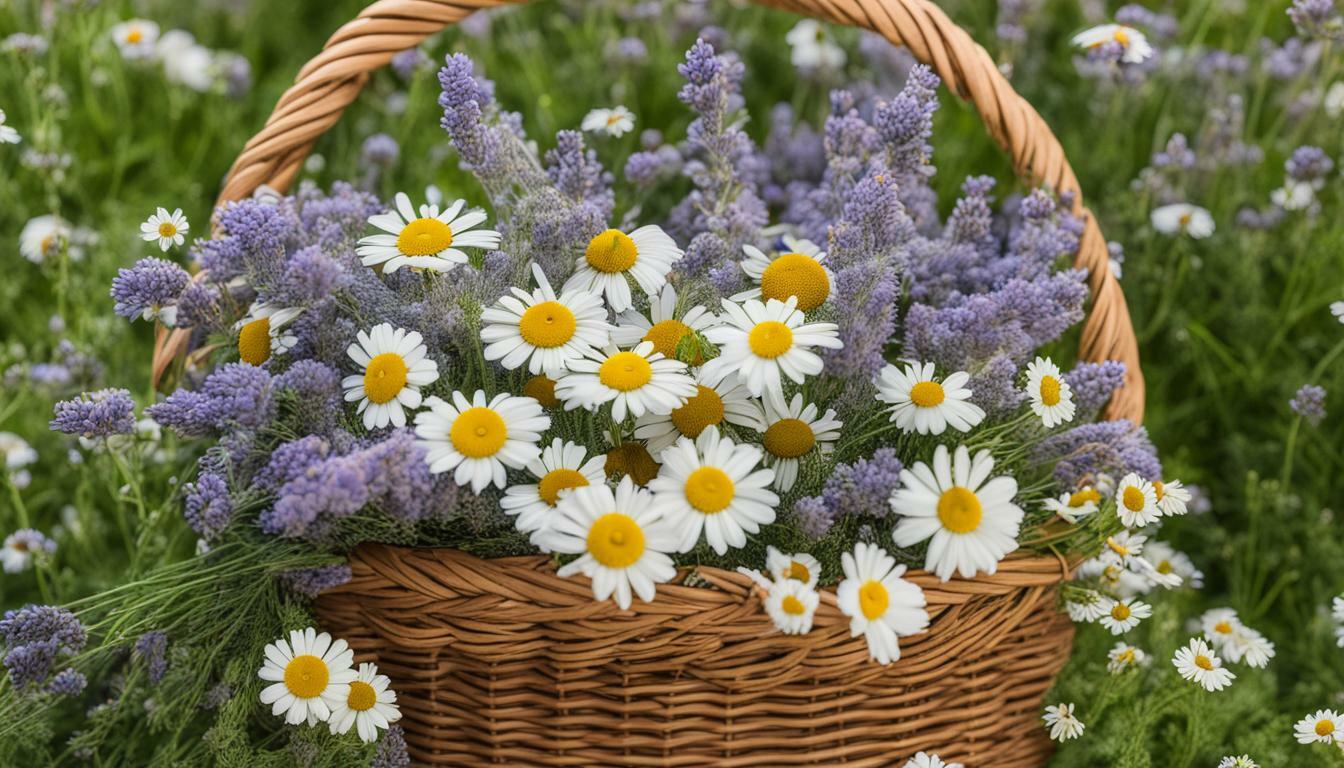
Creating Your DIY Herbal First Aid Kit
Now that you have a good understanding of herbal remedies and their healing properties, it’s time to start putting together your very own DIY Herbal First Aid Kit. Having a well-equipped kit on hand can help you deal with common ailments and injuries quickly and safely. Here are some tips on creating your own kit:
What You’ll Need
Before you start assembling your kit, make sure you have all the necessary supplies and containers. Here are some things you’ll need:
- A suitable container for your herbs and remedies. Glass jars with tight lids are ideal as they keep the herbs fresh and are easy to label.
- A mortar and pestle for grinding and mixing herbs.
- Measuring tools such as a tablespoon or scale to ensure proper proportions of herbs and ingredients in your remedies.
- Cotton gauze or cheesecloth for straining your herbal preparations.
- Labeling supplies to ensure your remedies are properly labeled with ingredients, instructions for use, and expiration dates.
Selecting Your Herbs
When selecting herbs for your kit, it’s important to choose a variety of herbs that can treat a range of conditions. Here are some common herbs to consider:
| Herb | Properties |
|---|---|
| Calendula | antiseptic, anti-inflammatory, promotes healing of cuts and burns |
| Echinacea | stimulates immune system, treats cold and flu |
| Lavender | antibacterial, antiseptic, promotes relaxation, treats headaches |
| Chamomile | anti-inflammatory, promotes relaxation, treats anxiety, digestive disorders, and skin irritations |
When sourcing your herbs, be sure to choose high-quality, organic options whenever possible. This will ensure that your remedies are safe and effective.
Preparing Your Remedies
There are several methods of preparing herbal remedies, including infusions, decoctions, and tinctures. Each method has its own benefits and is suitable for different types of herbs and ailments. Here are some basic steps for each method:
- Infusions: Pour a cup of boiling water over 1-2 teaspoons of dried herb, cover, and steep for 5-10 minutes. Strain and drink as a tea.
- Decoctions: Simmer 1-2 teaspoons of dried herb in a cup of water for 10-15 minutes. Strain and drink as a tea.
- Tinctures: Combine dried herbs with alcohol in a glass jar and let steep for several weeks. Strain and store in a dark glass bottle.
Remember to always follow instructions carefully and take appropriate safety precautions when preparing your remedies.
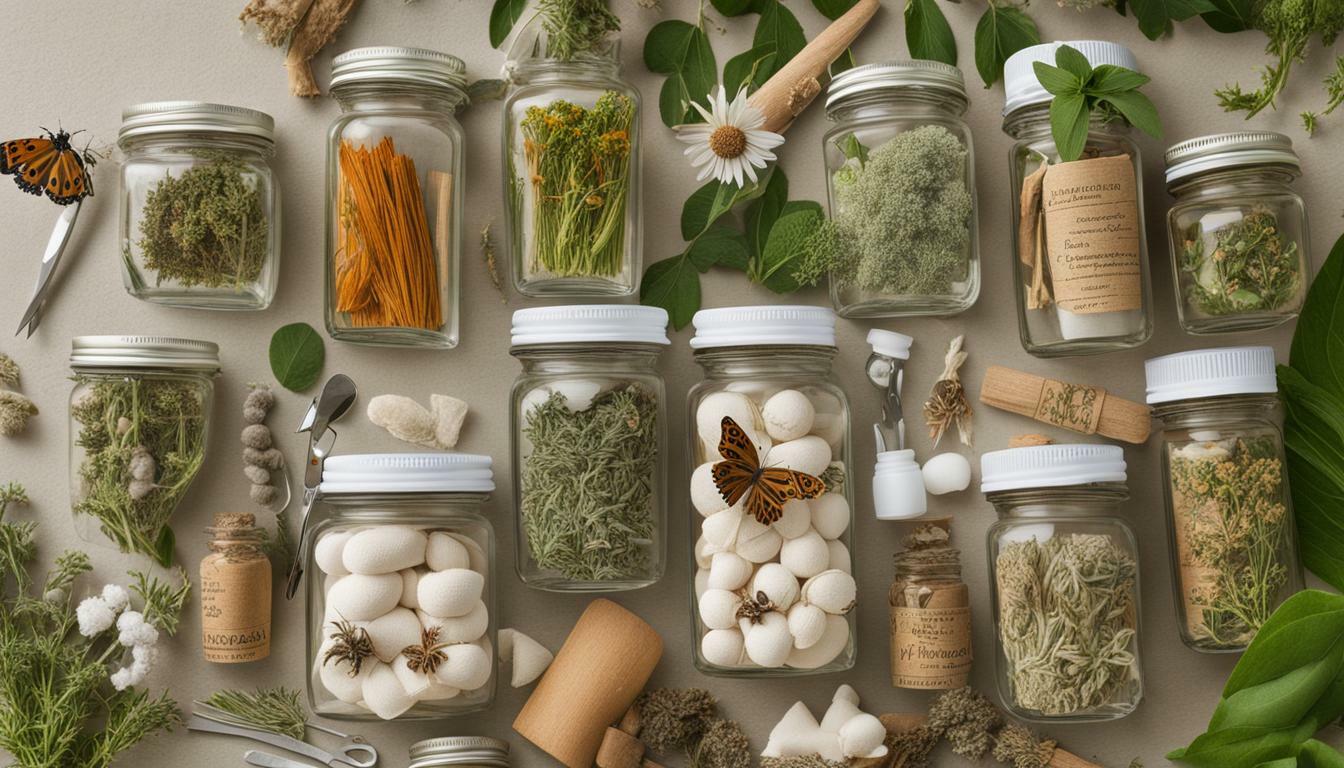
Now that you’ve selected your herbs and prepared your remedies, it’s time to assemble your kit. Organize your herbs and remedies in a logical manner that makes sense to you. Label everything clearly with ingredients, instructions, and expiration dates.
By creating your own DIY Herbal First Aid Kit, you’ll always be prepared to deal with common health issues quickly, safely, and naturally. This is a great way to take control of your own health and embrace the benefits of herbal healing.
Safety Considerations and Precautions
While herbal remedies can be a safe and effective alternative to conventional medicine, it is important to understand that they can interact with medications and cause allergic reactions.
Before using herbal remedies, consult with a healthcare professional, especially if you are currently taking prescription medications or have pre-existing medical conditions.
Additionally, it is important to properly identify and source herbs to ensure their safety and efficacy. Use reputable suppliers, and consider using organic and sustainable options whenever possible.
| Herbal Medicine | Herbal Healing |
|---|---|
| Do not exceed recommended dosages | Use caution when using essential oils topically, as they can cause skin irritation |
| Do not use if pregnant or breastfeeding without consulting a healthcare professional | If you experience any adverse reactions or symptoms, discontinue use and seek medical attention |
| Avoid using herbs if you have a known allergy to them | Store herbs properly to maintain their potency and shelf life |
By following these safety considerations and precautions, you can safely and effectively incorporate herbal remedies into your DIY Herbal First Aid Kit and overall health and wellness routine.
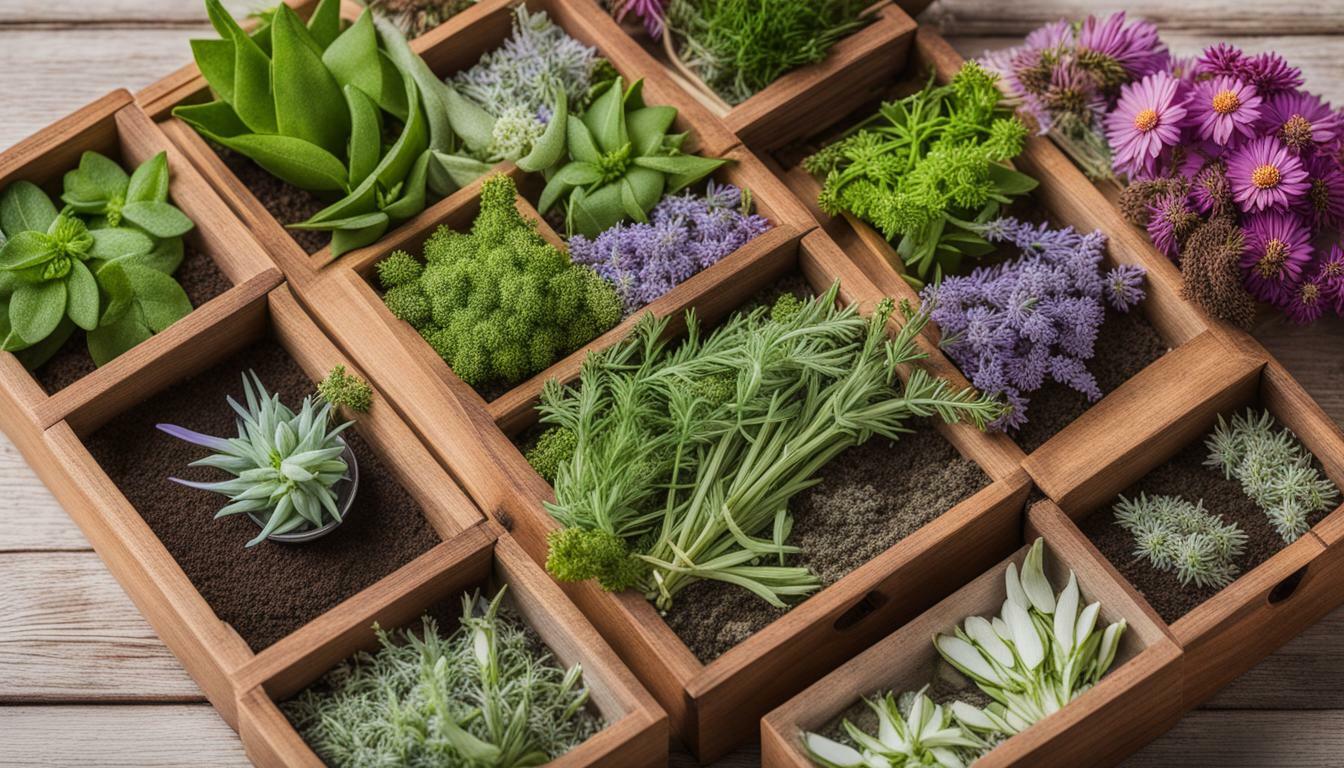
Integrating Herbal First Aid into Your Lifestyle
Herbal healing is not just about treating ailments and injuries when they happen, but also about promoting overall wellness. By incorporating herbal remedies into your daily routine, you can take advantage of nature’s healing power and improve your overall health.
Herbal healing can be as simple as drinking a cup of herbal tea or taking a herbal supplement to support your immune system. It can also involve using herbs in cooking or aromatherapy to promote relaxation and reduce stress.
One of the benefits of using herbal remedies for preventive care is that they are generally safe and have fewer side effects than pharmaceutical drugs. By taking a proactive approach to your health with herbal remedies, you can reduce your reliance on traditional medicine and improve your quality of life.
Another way to integrate herbal first aid into your lifestyle is to explore other holistic practices, such as meditation, yoga, and acupuncture. These practices can work in conjunction with herbal healing to promote overall health and wellness.
Remember, before incorporating herbal remedies into your lifestyle, it’s important to consult with a healthcare professional, especially if you have pre-existing medical conditions or are taking prescription medications.
For more information on herbal healing and incorporating it into a holistic lifestyle, check out these resources:
- Herbal Academy – offers courses, recipes, and articles on herbalism and natural health
- HerbMentor – an online community for herbal enthusiasts, featuring courses, podcasts, and forums
- Botanical Medicine for Women’s Health – a book by Dr. Aviva Romm that explores the use of herbs for women’s health
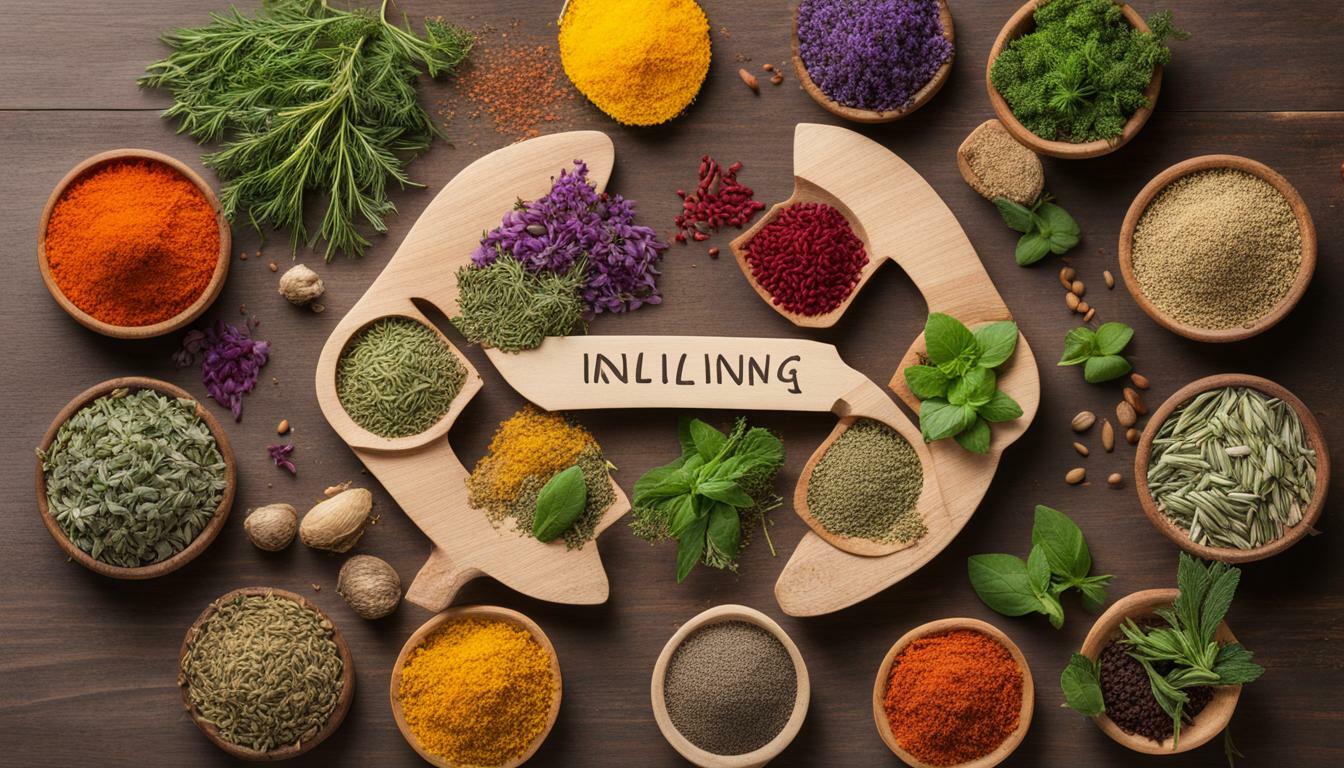
Case Studies: Herbal First Aid Success Stories
Herbal remedies have been trusted for centuries as an effective form of healing. Here are a few case studies that demonstrate the power of herbal first aid:
- Case 1: A woman burned her hand while cooking and immediately applied lavender essential oil to the affected area. The burning sensation subsided and the skin healed quickly without a scar.
- Case 2: A man experienced severe muscle pain after a workout and used a herbal salve containing arnica, comfrey, and St. John’s Wort. The salve provided relief within minutes and he was able to continue his workout without discomfort.
- Case 3: A child had a fever and was given a homemade herbal tea containing elderflowers, yarrow, and peppermint. The fever broke within a few hours and the child’s condition improved without the need for medication.
These success stories highlight the effectiveness of herbal remedies in providing first aid care. By creating your own DIY Herbal First Aid Kit, you too can harness the healing power of nature and promote a healthier, more holistic lifestyle.

Conclusion
Creating your own DIY Herbal First Aid Kit is a powerful way to harness the healing power of nature and take control of your own health and safety. By understanding the properties of different herbs and their applications, you can provide natural first aid remedies for a variety of common conditions and injuries.
Integrating herbal healing into your lifestyle can promote overall wellness and preventive care. However, it’s important to take safety precautions and consult with a healthcare professional before using herbal remedies, especially if you have pre-existing medical conditions or are taking medications.
With a little research and preparation, you can assemble your own herbal first aid kit and be prepared for whatever life throws your way. Embrace the benefits of natural healing and explore the world of DIY remedies today!
